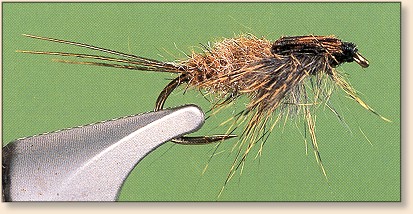Clinger Nymph
By Dave Hughes
Clingers, as their name implies, grip bottom stones tightly,
and are able to live right in the midst of the most brutal
flows. They are not found in lakes or ponds, but can be
found in most types of moving water, from the fastest
rapids and cascades to more peaceful and meandering tailouts
and flats. They'll be most abundant where nature creates
the most microniches for the; small spaces between and
beneath pebbles and stones. So you'll find the greatest
numbers of these nymphs associated with the gravel and cobble
substrate of riffles and runs.
Many clinger nymphs, when ready for emergence, swim to the top
or to within inches from it, like the crawlers, where the dun
excapes the nymphal shuck. Some trout concentrate on this
pre-emerger phase, and you'll do well fishing an imitation
between one and two feet deep. My friends and I often fish
rough searching nymphs in the approximate size and color of
the nymph we know is out there, on the bottom or a foot or
two deep, in the hours before a hatch that we know will occur
later in the day. When the hatch begins, we watch for signs
that trout are taking floating duns consistently before
we make the switch from nymphs to dries.
Natural clinger nymphs vary from tiny size 20s in their
early instars up to large size 10s. Near maturity most
average size 12 to 16, and that is therefore the sizes
trout are most likely to feed on selectively. Colors
reflect the dark bottoms on which clinger nymphs live,
and vary from tannish-olive to brownish-black. You can
vary the following dressing in size and color to match any
clinger nymph you might collect.
Materials List: Clinger Nymph
Hook: Standard nymph, 1X or 2X long, size 10 to 18.
Weight: Lead wire outriggers.
Thread: Black 6/0 or 8/0.
Tails: Pheassant tail fibers, splayed.
*Abdomen: Fur or synthetic dubbing, clipped top and
bottom.
Wingcase: Turkey or goose feather section.
Thorax: Muskrat, Australian opossum, or squirrel fur,
with guard hairs.
*Note: I prefer a mix of rabbit fur and Antron fibers for
the flattened abdomen, but you can use anything that dubs roughly,
and therefore can be clipped to form a wide but thin body.
Instructions - Clinger Nymph:
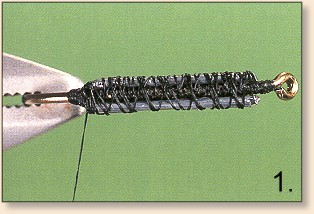
1. Insert a hook in the vise and layer the shank with
theread. Lash a short piece of lead wire, the diameter of
the hook shank, to the far side. Lash a second piece to
the near side. Be sure to leave room to tie in the tail
and finish the head.
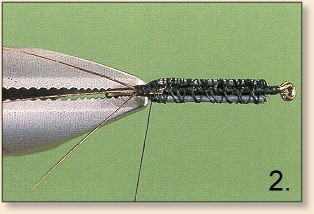
2. Form a slight hump, over which to splay the tails, with
a few extra turns of thread at the bend of the hook. Measure
three pheasant tail fibers the length of the hook shank or
a little shorter, and tie them in so they are spread evenly.
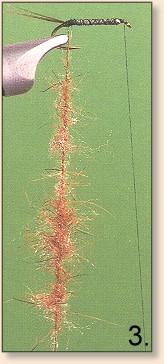
3. Make a very loose dubbing rope with your chosen abdomen
fur. To do this, wax your thread well, then spread the
dubbing loose and wide on the thread. Capture the working
thread over your forefinger, return it to the hook shank,
and secure it with a few turns. Then let the thread collapse
onto the fur and twist the end until you have a wide fur rope.
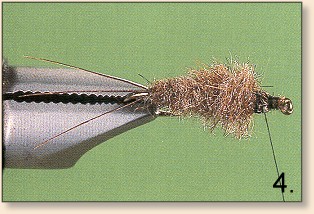
4. Wrap this fur rope forward over two-thirds of the hook shank.
Clip it tightly on the top and on the underside. Make a slanted
cut on the far side, from wide at the head to close at the tail.
Make a similar cut on the near side. The result should be a
flattened wedge.

5. Clip a feather section about the width of the hook
gap. Tie this windcase in at the end of the abdomen.
Clip a patch of fur from the hide you've chosen. Leave the
guard hairs in. You'll often need to clip the fur at
the butt ends to shorten it to an appropriate length.
Form a spiky dubbing rope with this fur. Moisten your
fingertips and stroke this rope until all the fur comes
from one side of the rope.
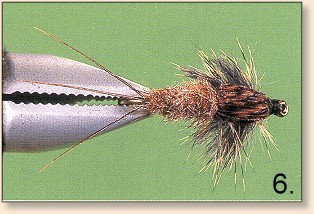
6. Wind this fur rope to the hook eye, stroking it back
as you take each wrap forward. Clip the fur from the top
of the shank, and draw the wingcase forward. Tie it off
behind the hook eye, clip the excess, make a neat thread
head, and whip-finish the fly. Tidy it up, if you'd like,
by plucking stray hairs from the sides and bottom.
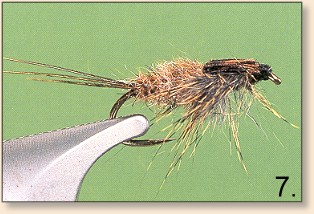
This style fly is based on a similar dressing in Poul Jorgensen's
Modern Fly Dressings for the Practical Angler
(Winchester Press, 1976), one of the finest works ever
written on the art of tying flies, I'd recommend you tie
and carry the style with a brown abdomen, red fox squirrel
thorax, and turkey wingcases, in sizes 12 to 16. It will
work for most clingers. If you collect specimens this
version fails to match, then vary the color of the
components until you find what the trout desire.
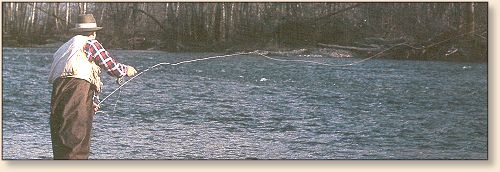
Fishing the Clinger Nymph
Fish clinger dressing in one of two ways: either right along
the bottom in fast water or along the edges of it, or else
up near the top in the same water or in currents that are
somethat slower. To fish a clinger nymph on the bottom, rig
with split shot and strike indicator. Vary the amount of
shot and distance between the shot and indicator to make
sure you get the fly into the strike zone. If you fail
to take trout with this method, it's more likely you've
not getting down far enough than it is that you've got
the wrong fly. This is especially true in swift water.
Fish with this method over the broad expanse of a riffle
or run, or concentrate your casts along current seams off
to the edge of riffles, runs, and even rapids. You can
use the same shot and indicator setup to probe pockets
in fast water, but once again be sure that you get the
fly to the bottom.
When fishing the same style fly during a hatch, for trout
concentrating on nymphs rather than duns, you can make
your presentation in one of two ways. The first is the
standard wet fly swing. This old method can be very
effective, because the naturals are seen by trout in the
process of rising toward the surface, though their
swimming is beeble. An imitative nymph fished on the swing
reflects this behavior well, but you must slow the swing
with constand mends if the fly begins to swim faster than
a natural might.
The second method for fishing a clinger nymph during a hatch
is to rig precisely as you might with a dry fly, using a
long leader and fine tippet. Make your casts upstream, or
better yet up-and-across the current, in such a way that you
get a natural dead drift right down the feeding lane of
visibly working trout. You're fishing the nymph as you would
a dry, but you've got to be far more watchful for signs of
a take. If your line tip moves upstream an inch, or you see
the flash of a turning flank or white of an opening mouth,
raise the rod tip to set the hook.
Chances are a trout will be out there, attached to your
dead-drifted clinger nymph. ~ Dave Hughes
Credits: From Matching Mayflies
by Dave Hughes and published by Frank Amato Publications.
We appreciate use permission.
|

